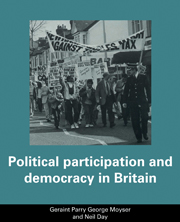Book contents
- Frontmatter
- Contents
- List of figures
- List of charts and maps
- List of tables
- Preface
- Part I Theories and methods
- Part II Patterns and pathways
- Part III Issues and actions
- Part IV The local process
- 14 The local political scene
- 15 Local participation
- 16 Local elites, activists and agendas
- 17 Participation and the making of the local agendas
- 18 The quality of local participation
- Part V Conclusions
- Appendix A Survey methods
- Appendix B Measuring elite-citizen concurrence
- Appendix C The National Questionnaire
- Endnotes
- Bibliography
- Index
17 - Participation and the making of the local agendas
Published online by Cambridge University Press: 03 May 2011
- Frontmatter
- Contents
- List of figures
- List of charts and maps
- List of tables
- Preface
- Part I Theories and methods
- Part II Patterns and pathways
- Part III Issues and actions
- Part IV The local process
- 14 The local political scene
- 15 Local participation
- 16 Local elites, activists and agendas
- 17 Participation and the making of the local agendas
- 18 The quality of local participation
- Part V Conclusions
- Appendix A Survey methods
- Appendix B Measuring elite-citizen concurrence
- Appendix C The National Questionnaire
- Endnotes
- Bibliography
- Index
Summary
In chapter 16 the agendas of citizens and elites were set side by side in order to provide an overall picture of the ways in which priorities varied both between localities and within them. However, such tables do not enable us very readily to compare the extent of local consensus. Nor, most crucially for the purposes of this volume, do they present the evidence in a way that helps the reader to appreciate the relationship between the agendas of the active, participatory citizens and of the elites which are the targets of their action.
In order to compare agendas in this way, a measure of ‘concurrence’ has been developed. As is so often the case in participation studies, concurrence owes its origins to the work of Verba and Nie (1972:299–341; 412–4). Concurrence ‘measures the extent to which citizens and leaders in the community choose the same “agenda” of community priorities’ (Verba and Nie 1972: 302). Each citizen is given a ‘concurrence score’ based on the frequency with which the problems he or she mentions also appear on the list of priorities of the elite as a whole. Similarly, each member of the elite has a concurrence score representing the match with the agenda of the citizens in the locality.
The method of constructing the concurrence score is an adaptation of that employed by Verba and Nie (for details see appendix B).
- Type
- Chapter
- Information
- Political Participation and Democracy in Britain , pp. 365 - 388Publisher: Cambridge University PressPrint publication year: 1992



